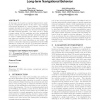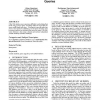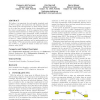WWW
2004
ACM
15 years 8 days ago
2004
ACM
In this paper we describe a practical framework for studying the navigational behavior of the users of an e-learning environment integrated in a virtual campus. The students navig...
WWW
2004
ACM
15 years 8 days ago
2004
ACM
As web service technology matures there is growing interest in exploiting workflow techniques to coordinate web services. Bioinformaticians are a user community who combine web re...
WWW
2004
ACM
15 years 8 days ago
2004
ACM
The goal of this research is the improvement of browsing voluminous InkML data in two areas: ease of rendering continuous inkflow for replay-browsing, and ease of random access na...
WWW
2004
ACM
15 years 8 days ago
2004
ACM
The Semantic Web relies on the complex interaction of several technologies involving ontologies. Therefore, sophisticated Semantic Web applications typically comprise more than on...
WWW
2004
ACM
15 years 8 days ago
2004
ACM
We present a system that tries to automatically collect and monitor Japanese blog collections that include not only ones made with blog softwares but also ones written as normal w...
WWW
2004
ACM
15 years 8 days ago
2004
ACM
Often Web database users experience difficulty in articulating their needs using a precise query. Providing ranked set of possible answers would benefit such users. We propose to ...
WWW
2004
ACM
15 years 8 days ago
2004
ACM
Search engines use content and link information to crawl, index, retrieve, and rank Web pages. The correlations between similarity measures based on these cues and on semantic ass...
WWW
2004
ACM
15 years 8 days ago
2004
ACM
We believe it is important for web graphic standards such as SVG to support user interaction and diagrams that can adapt their layout and appearance to their viewing context so as...
WWW
2004
ACM
15 years 8 days ago
2004
ACM
This paper presents a novel approach of using web log data generated by course management systems (CMS) to help instructors become aware of what is happening in distance learning ...
WWW
2004
ACM
15 years 8 days ago
2004
ACM
Theoretical analysis of the Web graph is often used to improve the efficiency of search engines. The PageRank algorithm, proposed by [5], is used by the Google search engine [4] t...



